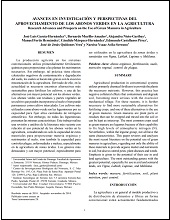AVANCES EN INVESTIGACIÓN Y PERSPECTIVAS DEL APROVECHAMIENTO DE LOS ABONOS VERDES EN LA AGRICULTURA
Research Advances and Prospects on the Use of Green Manures in Agriculture
Author
JOSE LUIS GARCIA HERNANDEZ
BERNARDO MURILLO AMADOR
ALEJANDRA NIETO GARIBAY
Manuel Fortis Hernández
CANDIDO MARQUEZ HERNANDEZ
EDMUNDO CASTELLANOS PEREZ
NARCISO YSAC AVILA SERRANO
Metadata
Show full item recordAbstract
"La producción agrícola en los sistemas convencionales utiliza primordialmente fertilizantes químicos para proporcionar a las plantas los nutrimentos necesarios. Sin embargo, tal práctica tiene efectos colaterales negativos de contaminación y degradación del suelo, los cuales se hacen más graves con la excesiva mecanización de la agricultura. Derivado de ello, en la actualidad es necesario encontrar alternativas más sustentables para fertilizar los cultivos; y una de las alternativas con mayor potencial son los abonos verdes. Los abonos verdes son residuos y partes vegetales de un cultivo que pueden incorporarse al suelo o bien puede permanecer como cultivo intercalado. Los cultivos más utilizados como abono verde son las leguminosas por su capacidad para fijar altas cantidades de nitrógeno atmosférico. Sin embargo, no todas las leguminosas presentan las mismas características. Este trabajo realiza una revisión y análisis de la literatura más reciente con relación al uso potencial de los abonos verdes en la agricultura, considerando no solo la capacidad de estos materiales para proporcionar materia orgánica y nutrimentos al suelo, sino también la capacidad para controlar plagas, enfermedades y maleza; especialmente en la agricultura de zonas áridas. Los géneros más destacados y con mayor potencial, especialmente para ser utilizados en la agricultura de zonas áridas y semiáridas son Vigna, Lablab, Lupinus y Melilotus." "Agricultural production in conventional systems utilizes primarily chemical fertilizers to provide the plants the necessary nutrients. However, this practice has negative collateral effects that contaminate and degrade soil, becoming more serious with the excessive mechanical tillage. For these reasons, it is further necessary to find more sustainable alternatives for fertilizing crops, and one of these alternatives is the use of green manures. Green manures are plant parts or residues that can be cropped and mixed into the soil or can be kept as intercrop. The most common crops used as green manure are legumes because of their capability to fix high levels of atmospheric nitrogen (N). Nevertheless, within the legume group, not all have the same characteristics. This paper reviews and analyzes the most recent literature on the potential use of green manures in agriculture, regarding not only the ability of these materials to provide organic matter and nutriments to soil, but also to control pests, plant diseases and weeds. Emphasis is given to the potential of their use in arid land agriculture. The most outstanding genera with the greatest potential, especially for use in arid and semiarid lands, are Vigna, Lablab, Lupinus, and Melilotus."
Collections
Related items
Showing items related by title, author, creator and subject.
-
PROMOCIÓN DEL PERIFITON PARA EL CULTIVO DE CAMARÓN BLANCO: HACIA UNA ACUICULTURA ECOLÓGICA
DOMENICO VOLTOLINA LOBINA; JUAN MANUEL AUDELO NARANJO; MARIA DEL ROSARIO PACHECO MARGES -
Suelo y Erosión
YOLANDA LOURDES MAYA DELGADO


